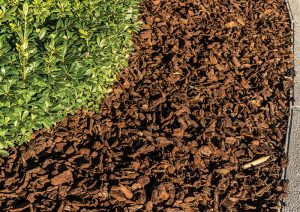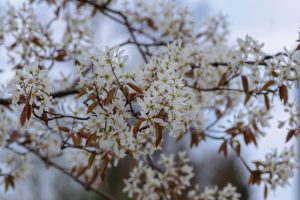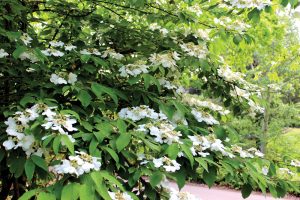— By Trent Limban —
The right products for cost-efficient landscape curb appeal.
Maintaining your landscaping is an important factor in keeping your customers coming back as well as attracting new customers. The best and easiest way to maintain the landscaping for each of your stores is to pick products, such as mulch, plants and fertilizer, that are low maintenance and that work best in the climate where the store is located. This will ensure cost-effective solutions that are long term and low maintenance.

Trent Limban, DENTCO
Having picture perfect landscaping does not have to cost an arm and a leg. Here are a few tips on selecting the right products for each of your locations that will save money in the long term.
Mulch
When it comes to mulch, you want something that will provide weed control and maintain moisture levels, as well as hold up over time. Some of the commonly used mulch types are organic, rubber, stone, pine straw and decomposed crushed granite. Beyond mulch’s practical purposes, it also makes a landscape look more appealing.
Organic Mulch
- Common in the northern half of the U.S., it’s the industry standard and common practice in these areas.
 Organic mulch, such as shredded, bark and wood chips, is popular because it has a low upfront cost and helps with weed control and retaining moisture. A downside of organic mulch is that it breaks down and decomposes over time and has to be redone every season. It is also relatively light and can move, wash out or float during heavy rainfall.
Organic mulch, such as shredded, bark and wood chips, is popular because it has a low upfront cost and helps with weed control and retaining moisture. A downside of organic mulch is that it breaks down and decomposes over time and has to be redone every season. It is also relatively light and can move, wash out or float during heavy rainfall.
Rubber Mulch
- A relatively new product to the industry, available nationwide.
Rubber mulch, an environmentally friendly option made from recycled tires, is a great alternative to organic mulch. It provides good insulation from heat, and doesn’t break down or attract insects, such as termites and ants. Rubber mulch also discourages weed and fungal growth because it is nonporous and weeds can’t thrive on the rubber.
Rubber mulch also has a long “shelf life” and doesn’t need to be redone every year — making this nearly maintenance free. While the upfront cost is around three times higher per yard when compared to organic mulch, it can pay off in the long run. Rubber mulch can last for 3 to 5 years before needing to be replenished or top dressed. Rubber mulch can also hold its color for up to 10 years, and is heavier than organic mulch, so it is not as likely to be displaced during storms.
Stone
- The primary alternative to organic mulch nationwide.
Landscaping stone holds up similar to rubber mulch and is also a higher upfront cost (typically three to seven times the cost) than organic mulch. The price of stone varies depending on regional availability and distance from the source. Stone is typically a one-time purchase because of its durability, and it does not decompose or decay. On average, stone installs will pay for themselves in about 5 years. It is aesthetically pleasing and provides a striking contrast to brightly colored plants and improves a landscape’s appearance.
Stones can also double as a garden bed edge to keep soil in place and minimize erosion. While stone is not easily disturbed by wind, rain or foot traffic, it can be a catch-all for leaves and other yard debris. The best way to clean this is with a leaf vacuum, as long as the rocks aren’t too small.
Pine Straw
- Common and cost-effective in the Southeast U.S.
Pine straw, made of old pine needles, is common in the Carolinas and Tennessee as a mulch alternative. It is also a low-cost option as it is sourced regionally in the Southeast.
Decomposed Crushed Granite
- Common and cost-effective in the Southwest U.S.
This type of mulch is very common in the Southwestern areas of the U.S. The more it rains, the more compact it gets. It’s best to use in landscaping beds or under a canopy of trees where plants and grass have a hard time growing. The best part is that it has a longer life but does need to be refreshed or top dressed as needed and does not attract pests.
Pick the Right Plants for the Right Place
When selecting plants, pick native plants that grow well in your climate. Be aware of whether a plant requires full sun or shade, and the soil type. If you choose the right plants up front, it will save you money in the long run. It also is important to consider the growth habit, and how large the plant will become when it has reached maturity. Spending time up front to ensure this happens will prevent beds from becoming overgrown in the future.
 Here’s a sample list of native plants that grow well in different areas of the country:
Here’s a sample list of native plants that grow well in different areas of the country:
Southwest Native Plants
- Autumn sage: Bears evergreen leaves and clusters of red, purple, pink or violet flowers from late summer through autumn. It’s a favorite of hummingbirds and butterflies.
- Bunny ears cactus: Evergreen cactus that is as cute as its name and rarely produces spines. Bright yellow flowers appear in spring and summer.
Midwest and Northeast Native Plants
- Serviceberry: Adaptable, flowering shrub that attracts birds and desirable pollinator insects. Grows in drought or wet conditions and in full or part sun.
- Viburnum: Shrubs that grow in many different sizes and are adaptable to varying levels of soil moisture and can tolerate full or part sun.
Pacific Northwest Native Plants
- Broadleaf Lupine: Drought-tolerant evergreen that offers silvery leaves and blue-violet flowers in spring. Perfect for the back edge of a bed.
- Lewisia: One of the Northwest’s most beautiful wildflowers, it blooms pink, red and white flowers in the spring and summer. It does well as a winter accent, needs excellent drainage and does well in rock gardens.
Southeast Native Plants
- Hardy Hibiscus: Shrub with big, bold flowers that bloom late summer and early fall.
- Piedmont Azalea: With delicate light white-pink blooms, it easily blends into a woodland garden or formal planting bed.
Install Smart Irrigation Controllers
 To save water and manage irrigation remotely, you can convert your irrigation system to a smart irrigation controller, which costs about $200 for installation. The price of the controller will vary depending on make and model. You can program your irrigation based on soil type and log in from an app to adjust timing. This helps you be more efficient with watering, and make last minute adjustments if the weather changes.
To save water and manage irrigation remotely, you can convert your irrigation system to a smart irrigation controller, which costs about $200 for installation. The price of the controller will vary depending on make and model. You can program your irrigation based on soil type and log in from an app to adjust timing. This helps you be more efficient with watering, and make last minute adjustments if the weather changes.
Turfgrass Fertilizer and Weed Control
To keep the grass looking healthy and control weed growth, have your landscape fertilized on the right schedule.
In Southern climates where warm season grasses grow, only one fertilizer application is needed for St. Augustine grass in late May or early June. Bermuda grass is more nitrogen hungry and requires more fertilizer applications similar to Northern climates, which require three or four applications per year. A common source of nitrogen can be applied with a Sulfur Coated Urea 44-0-0. This product slow releases into the soil to keep turfgrass healthy.
For weed control, do a pre-emergent in spring to control weeds before growing and a post-emergent to treat weeds after they start growing.
As you can see, there are many options to make your landscape appealing. The best approach is to be proactive and pick products that are best for your climate to minimize maintenance and to be cost-effective.
— Trent Limban is director of quality services for DENTCO, a national exterior services maintenance company based in Dewitt, Michigan.
